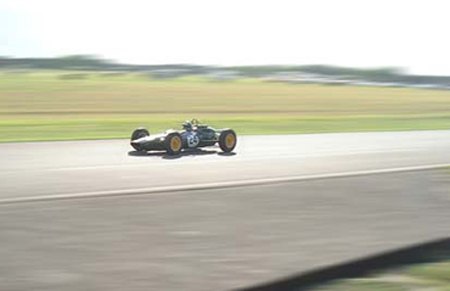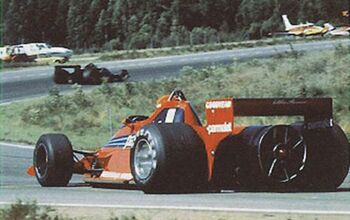F1 History Pt. 2: The Lotus Era
From a layout standpoint, John Cooper’s revolutionary mid-engine design brought F1 cars into their modern form. Dynamically superior, mechanically simpler and cheaper to construct than its front-engine predecessors, the Cooper was a revelation. Cooper’s design, however, was not the pinnacle of F1 car design. In keeping with F1’s history of innovation and constant development, new designers soon arose to bring F1 its next big thing.
Colin Chapman’s first GP cars, the Lotus 12 and 16, debuted at Monaco in 1958. The team saw only passing success in its early years. Three years after its introduction, at the 1960 Monaco GP, a Lotus scored its first win. The marque emerged victorious with Stirling Moss behind the wheel of a Rob Walker customer Lotus 18. While Lotus was reasonably successful following its first win, the real leap forward took the form of the Lotus 25.
The 25’s predecessor was a typical GP car of its day: tubular space frame construction with a mid-engine layout. The 25 took a drastic step forward with the introduction of monocoque construction. Taken from aircraft design, the construction method essentially entails doing away with the frame (onto with the mechanicals and body were bolted), and using the car’s own body– it exoskeleton– to support its internals.
By doing away with the bulky, flimsy space frame, Chapman was able to significantly increase the stiffness of the body of the 25. This allowed for exponentially greater control of suspension geometry and much greater precision in design. Doubling the cross-sectional area of a tube increases its stiffness by a factor of 16. The chassis of the Lotus 25 was three times as stiff and half as heavy as that of the 24.
The 25 was a beautiful car, low and sleek. The philosophy that defined Chapman’s thinking on the 25 was simple. According to the English engineer, a race car had only five essential components: engine, gearbox, fuel tank, wheels and driver. The machine weighed in at only 450 kilos, powered by a 195 hp Coventry Climax V-8. The cramped cockpit was barely large enough for Jim Clark’s thin frame. The 25’s simplicity, strength and packaging benefits made it dramatically superior to its competitors.
Monocoque construction was not new to racing car design, having been successfully applied in the legendary Jaguar D-Type. But it was new to F1, and completely redefined the modern GP car. Every F1 car designed after the Lotus 25 has incorporated some form of monocoque construction, from its Lotus descendants to the carbon-fiber missiles seen on track today.
Chapman’s cars carried Jimmy Clark to the 1963 and 1965 World Championships with an astounding seven and six wins in each season, respectively. In 1966, Chapman made the ill-fated decision to switch to the BRM H16 engine, which ultimately proved uncompetitive. The next year, however, Lotus began using the new Ford-Cosworth DFV engine. While the concept had been utilized with little success in the Lotus 43, the DFV allowed Lotus to use the engine as a stressed member of the chassis of its descendant, the Lotus 49.
The 49 was a terror machine. Its Ford-Cosworth power plant provided 415 hp at 9500 rpm and formed the spine of a machine that weighed only 500 kilos. The early DFV’s were notorious for their sudden, extraordinary power delivery. This characteristic made the 49 very difficult to drive to its potential. This design, an outgrowth of Chapman’s “simpler, lighter, faster” philosophy, provided a dramatic performance increase. The DFV won its first GP start at the Dutch GP at Zandvoort, powering a new Lotus 49, which was designed specifically for the engine. Graham Hill, in a Lotus 49, stormed to the 1968 World Championship.
The DFV went on to establish itself as the most successful F1 engine of all time, powering winning race cars for nearly 15 years. Sold as a customer engine, the DFV was literally the lifeblood of the independent constructors established in the wake of Cooper’s success.
It was this combination– the Ford-Cosworth DFV and Chapman’s novel monocoque construction– that represented the era’s technological peak. Immensely stiff, Chapman’s chassis allowed engineers to finally breed the ‘black magic’ out of GP car suspension development. This greater threshold of control also allowed for the fitment of wider, grippier tires, the width of which more than doubled between 1960 and 1969. Speeds rose in tandem.
In the 1960’s, Lotus established innovative design strategies that live on in today’s F1 cars. But F1’s biggest technological advance was just over the horizon. Aerodynamic downforce devices debuted in 1968. While wings had been utilized in other forms of racing, that year saw their first application on GP cars. This final piece in the performance triangle would prove to be the biggest shift in F1 history.
More by Mitchell Yelverton
Latest Car Reviews
Read moreLatest Product Reviews
Read moreRecent Comments
- 28-Cars-Later Ford reported it lost $132,000 for each of its 10,000 electric vehicles sold in the first quarter of 2024, according to CNN. The sales were down 20 percent from the first quarter of 2023 and would “drag down earnings for the company overall.”The losses include “hundreds of millions being spent on research and development of the next generation of EVs for Ford. Those investments are years away from paying off.” [if they ever are recouped, emphasis mine] Ford is the only major carmaker breaking out EV numbers by themselves. But other marques likely suffer similar losses. https://www.zerohedge.com/political/fords-120000-loss-vehicle-shows-california-ev-goals-are-impossible Given these facts, how did Tesla ever produce anything in volume let alone profit?
- AZFelix Let's forego all of this dilly-dallying with autonomous cars and cut right to the chase and the only real solution.
- Zelgadis Elantra NLine in Lava Orange. I will never buy a dirty dishwater car again. I need color in my life.
- Slavuta CX5 hands down. Only trunk space, where RAV4 is better.
- Kwik_Shift_Pro4X Oof 😣 for Tesla.https://www.naturalnews.com/2024-05-03-nhtsa-probes-tesla-recall-over-autopilot-concerns.html


































Comments
Join the conversation
Great article, tis always interesting to read about this stuff from time to time. To see the innovative and drastic improvements of the race machines over time. Too bad the same cannot be said of today's F1. Although it could, but the improvements are stubtle at best.
And I know where I’ll be a week later. Pretty fascinating to have skied with Jim Clark - how did that happen? At the time that F1 was running at St Jovite, I was the press relations officer and track commentator. Just to frost your socks, I was also F1 corresondent for Motorman magazine in NZ. Consequently, I was on first name terms with Denny and Bruce. Those were the days, sitting on the pitwall with no Ecclestone Ego in sight (thank heaven).